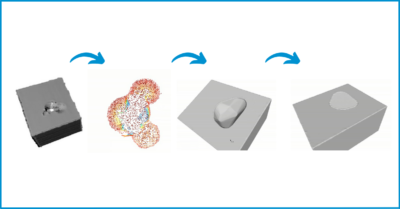Automated repair of parts
Partner:
University of Alberta, ADAMS Lab (Additive Design and Manufacturing Systems Laboratory)
Challenge:
High-value industries usually require human interference for part repairs. The process is time and cost-intensive. Another major drawback is the repeatability of the process. For instance, if a turbine blade is damaged and repaired via human intervention, the mechanical properties of the repaired blade vary significantly. In this project, ADAMS Lab is designing hardware and compatible software to autonomously repair multiple damaged manufacturing parts using 3D reconstruction, damaged volume extraction, and repair. The system deploys a 5-axis CNC machine and a hybrid manufacturing process.
Solution:
The LAMPP (Large-area Additive Manufacturing Prototyping Platform) is a 5-axis CNC system used for automated in-situ scan-assisted repair using hybrid manufacturing. The Photoneo 3D scanner is integrated and calibrated with the system for automated scanning sequence, 3D point cloud reconstruction, damaged volume extraction, and repair through hybrid manufacturing.
The following capabilities of the Photoneo 3D scanner are used: automatic scan using API, automatic scan registration using marker recognition for 3D point cloud reconstruction, and automatic data processing using Phoxi Control.
The onboard processor of the scanner simplifies data manipulation and 3D point cloud co-registration via marker pattern recognition.
The process looks as follows:
The system identifies the damaged volume using the PhoXi 3D Scanner. The damaged area is then extracted based on the point cloud data. A surface preparation algorithm is applied to avoid any collisions during the repair process. The surface of the prepared volume and the to-be-printed volume are computed. Both volumes can be exported into any CAM software for toolpath generation and repair.
Discussion:
ADAMS Lab used the Photoneo structured light 3D scanner model M for its high accuracy, repeatability, scanning range, and software capabilities. The provided API is user-friendly and exposes a lot of useful features for integration with robotics and automation.
Thanks to the Photoneo PhoXi 3D Scanner, the system guarantees high accuracy and repeatability of the scanning process and consequently also of the repair. With the LAMPP system, ADAMS Lab is able to reduce the time and costs of repair. This process is an alternative to expensive, time-consuming, and non-reliable manual mending. At the same time, this project delivers a repair solution for intricate manufactured parts such as turbine blades and increases their service life reliably.
A report of invention for this project has been submitted through the University of Alberta.
Would you like to know more about Photoneo technology and how it can benefit your applications?
